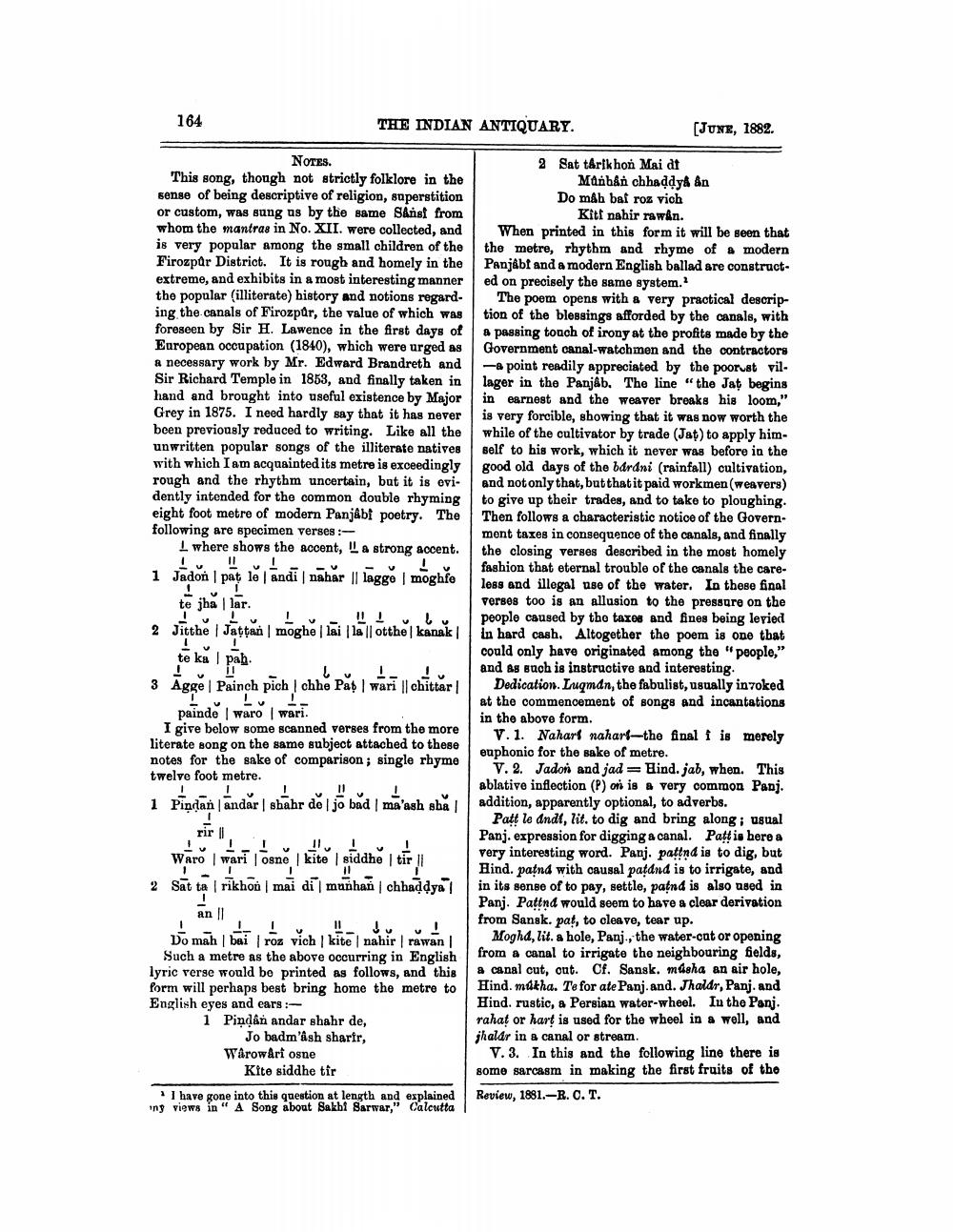________________
164
NOTES.
This song, though not strictly folklore in the sense of being descriptive of religion, superstition or custom, was sung us by the same Sânst from whom the mantras in No. XII. were collected, and is very popular among the small children of the Firozpur District. It is rough and homely in the extreme, and exhibits in a most interesting manner the popular (illiterate) history and notions regarding the canals of Firozpur, the value of which was foreseen by Sir H. Lawence in the first days of European occupation (1840), which were urged as a necessary work by Mr. Edward Brandreth and Sir Richard Temple in 1853, and finally taken in hand and brought into useful existence by Major Grey in 1875. I need hardly say that it has never been previously reduced to writing. Like all the unwritten popular songs of the illiterate natives with which I am acquainted its metre is exceedingly rough and the rhythm uncertain, but it is evidently intended for the common double rhyming eight foot metre of modern Panjabi poetry. The following are specimen verses:
1 where shows the accent, IL a strong accent. ! ! L 1 Jadon pat le|andi | nahar || lagge | moghfe
!
te jhalar.
し
L !!! 2 Jitthe Jattan | moghe | lai |la|| otthe| kanak |
|
te ka pah.
.
THE INDIAN ANTIQUARY.
し
3 Agge Painch pich | chhe Patwari || chittar |
T
L
painde warowari.
I give below some scanned verses from the more literate song on the same subject attached to these notes for the sake of comparison; single rhyme twelve foot metre.
.
.
1
1 Pindan andar | shahr de | jo bad | ma'ash sha |
rir
1
Waro wari osne | kite | siddhe | tir ||
1
I
1
11
11
2 Sat tarikhon | mai di munhan | chhaddya |
|| I JU! Do mah bai | roz vich | kite | nahir | rawan | Such a metre as the above occurring in English lyric verse would be printed as follows, and this form will perhaps best bring home the metre to English eyes and ears:
1 Pindan andar shahr de, Jo badm'âsh sharfr, Warowari osne Kite siddhe tir
I have gone into this question at length and explained ny views in "A Song about Sakhi Sarwar," Calcutta
[JUNE, 1882.
2 Sat tarikhon Mai dt Manhân chhaddy& &n Do mâh bai roz vich Kitt nahir rawan.
When printed in this form it will be seen that the metre, rhythm and rhyme of a modern Panjabf and a modern English ballad are constructed on precisely the same system."
The poem opens with a very practical description of the blessings afforded by the canals, with a passing touch of irony at the profits made by the Government canal-watchmen and the contractors a point readily appreciated by the poorest villager in the Panjab. The line "the Jat begins in earnest and the weaver breaks his loom," is very forcible, showing that it was now worth the while of the cultivator by trade (Jat) to apply himself to his work, which it never was before in the good old days of the bárdni (rainfall) cultivation, and not only that, but that it paid workmen (weavers) to give up their trades, and to take to ploughing. Then follows a characteristic notice of the Government taxes in consequence of the canals, and finally the closing verses described in the most homely fashion that eternal trouble of the canals the careless and illegal use of the water. In these final verses too is an allusion to the pressure on the people caused by the taxes and fines being levied in hard cash. Altogether the poem is one that could only have originated among the "people," and as such is instructive and interesting.
Dedication. Luqman, the fabulist, usually invoked at the commencement of songs and incantations in the above form.
V. 1. Nahart nahart-the final i is merely euphonic for the sake of metre.
V. 2. Jadon and jad Hind. jab, when. This ablative inflection (P) on is a very common Panj. addition, apparently optional, to adverbs.
Patt le andi, lit. to dig and bring along; usual Panj. expression for digging a canal. Paṭṭis here a very interesting word. Panj. paṭṭnd is to dig, but Hind. paṭnd with causal paṭand is to irrigate, and in its sense of to pay, settle, paṭnd is also used in Panj. Paṭṭnd would seem to have a clear derivation from Sansk. pat, to cleave, tear up.
Moghd, lit. a hole, Panj., the water-cut or opening from a canal to irrigate the neighbouring fields, a canal cut, cut. Cf. Sansk. músha an air hole, Hind. mukha. Te for ate Panj. and. Jhalar, Panj. and Hind. rustic, a Persian water-wheel. In the Panj. rahat or hart is used for the wheel in a well, and jhalar in a canal or stream.
V. 3. In this and the following line there is some sarcasm in making the first fruits of the Review, 1881.-R. C. T.




